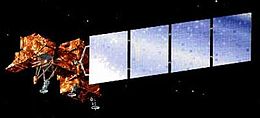 | |
| Mission type | Earth imaging |
|---|---|
| Operator | NASA / NOAA |
| COSPAR ID | 1993-F04[1] |
| Mission duration | Failed to orbit |
| Spacecraft properties | |
| Manufacturer | Martin Marietta |
| Launch mass | 2,750 kilograms (6,060 lb) |
| Power | 1259 watts |
| Start of mission | |
| Launch date | October 5, 1993 |
| Rocket | Titan II(23)G/Star-37XFP-ISS |
| Launch site | Vandenberg AFB SLC-4W |
| Orbital parameters | |
| Reference system | Geocentric |
| Regime | Sun-synchronous |
| Perigee altitude | 705 kilometres (438 mi) |
| Apogee altitude | 705 kilometres (438 mi) |
| Inclination | 98.3° |
| Period | 98.9 minutes |
| Epoch | Planned |
Landsat 6, equipped with upgraded versions of the instruments on Landsat 5, was designed to carry forward the Landsat program. It was launched on October 5, 1993 with a Titan II launch vehicle, but failed to reach orbit.[2] Landsat 6 omitted the Multi-Spectral Scanner found on its predecessors, but carried an Enhanced Thematic Mapper, which improved on the previous Thematic Mapper by adding a 15m-resolution panchromatic band.[3]
Development
The Landsat 6 satellite was built by Martin Marietta Astro Space.[4]
Design
Operations
The satellite was constructed from aluminum and used graphite struts. Landsat 6 had a hydrazine propulsion system. The spacecraft was powered by one solar array that had single-axis articulation and produced 1430 W. The power was stored in two NiCd batteries that had a capacity of 100 Ah. Data collected from the sensors was stored on tapes and transmitted to ground stations at 85 Mbit/s. The satellite was stabilized to 0.1 degrees in all three axes by using reaction wheels.[4]
Sensors
The Enhanced Thematic Mapper was designed and manufactured by Santa Barbara Research Center.[2]
Mission
Launch
Landsat 6 was launched aboard a Titan II launch vehicle from Vandenberg Air Force Base on October 5, 1993.[2]
Operations
Even though Landsat 6 separated from the rocket at the appropriate time and place, the satellite failed to reach orbit. Since fuel could not reach the reaction engines, the satellite could not maintain attitude control during the apogee kick motor (AKM) burn. This caused the satellite to tumble during the burn, resulting in a failure to orbit due to the wasted energy.[2]
Martin Marietta and NOAA both convened review boards to investigate the failure. Both boards determined that Landsat 6 did not achieve orbit due to a ruptured hydrazine manifold, and recommended a task force investigate hydrazine feed systems that were more reliable.[2]
References
- ^ "Landsat 6, 7". Gunter's Space Page. Retrieved March 20, 2020.
- ^ a b c d e "Landsat 6 failure attributed to ruptured manifold" (PDF) (Press release). NOAA. March 10, 1995.
- ^ "Landsat 6". USGS. Archived from the original on August 27, 2013. Retrieved July 17, 2017.
- ^ a b "Landsat-6". eoPortal Directory. Retrieved July 17, 2017.